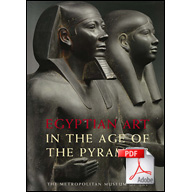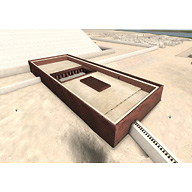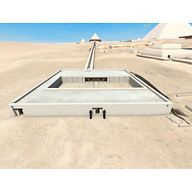-
- Format
- Article
-
- Language
- ENGLISH
-
- Year Published
- 1999
-
- Number of Pages
- 10
-
- Citation Text
- Arnold, Dieter. "Old Kingdom Statues in their Architectural Setting." In Egyptian Art in the Age of the Pyramids. New York: The Metropolitan Museum of Art, 1999, pp. 40-49.
-
- Individual - Ancient
- Babaef (G 5230)
- Hemiunu (G 4000)
- Hetepheres II (G 7110-7120)
- Idu (G 7102)
- Khafre
- Khufu
- Khuwiwer (G 8674)
- Menkaure
- Meresankh III (G 7530-7540)
- Qar (G 7101)
- Sahure
- Seneb (Seneb)
- Seshemnefer [III] (G 5170)
- Seshemnefer [II] (G 5080)
- Seshemnefer [IV] (Lepsius 53)
- Shepseskaf
- Snefru
-
- Publisher
- Metropolitan Museum of Art
-
- Author
- Dieter Arnold, German
-
- Site Name Menkaure Pyramid Complex
-
Colossal alabaster statue of Menkaure
- MFAB_09.204
-
Greywacke pair statue of Menkaure and Queen
- MFAB_11.1738
-
- HUMFA_13-11-91
-
- HUMFA_13-12-11
-
Reproduction of greywacke pair statue of Menkaure and Queen
- EMC_SR_2/15815
Ancient People
-
- Type Individual - Ancient
- Remarks Owner of G 5230. Name translated as either Khnumbaef or Babaef, identified variously as [sA nswt n Xt=f jrj-pat HAtj-a smr watj jmj-r kAt nb nswt xrp aH tAjtj sAb TAtj Xrj-Hb Hrj-tp Hm-nTr Hr THnw qA-a wr idt Hm st Hm jAqs Hm Hpwj (Hm) Hr SwA Hrj-sStA n mdw-nTr smsw snwt xt wr] king's son of his body, hereditary prince, count, sole companion, overseer of all royal works, director of the palace, chief justice and vizier, chief lector-priest, priest of Horus of Libya, elevated of arm, great of censing, servant of the throne, priest of the akes-ornament, priest of Hepwy, priest of Horus-Shewa(?), secretary of the sacred writings, elder of the snwt-house, khet-priest of the Great One. Six damaged limestone standing statues (14-11-92 = MFA 34.1461, 14-11-93 = MFA 34.235, 14-11-94 = MFA 21.953a-b, 14-11-95 = MFA 21.955a-b, 14-11-96 = MFA 21954a-b deaccessioned = MMA 64.66.2, 14-11-97 = MFA 21.956a-b deaccessioned = MMA 64.66.1) inscribed for Babaef; found in G 5230 S (= S chapel/serdab) SS-2. Four limestone statue bases (14-11-78, 14-11-79 = MFA 14.1686, 14-11-80 = MFA 14.1687, 14-11-81) inscribed for Babaef; found in G 5230 S (= S chapel/serdab) SS-1. Fragmentary black granite seated scribe statue (14-11-151 + 14-12-7 + 14-12-82 = MFA 21.931a-c) inscribed for Babaef; pieces found scattered in G 5230 S (= S chapel/serdab) room O, pit G 5221 A, and pit G 5211 A. Fragmentary incomplete red granite standing pair statue (14-11-84 = MFA 14.1688 + 14-11-89a = MFA 14.1690.1 + 14-11-89b = MFA 14.1690.2 + 14-11-89c = MFA 14.1690.3 + 14-11-117 = MFA 14.1960.2 + 14-11-118 = MFA 14.1697) inscribed for Babaef; pieces found scattered in G 5230 S (= S chapel/serdab) SS-1 and SS-2, and between mastabas G 5110 and G 5230. Fragmentary alabaster standing statue (fragments from 14-2-2 + 14-2-4 + 14-3-1 = MFA 24.603 reconstructed statue) inscribed for Babaef; found scattered in vicinity of G 4620 and G 4820. Fragments of alabaster seated statue (15-1-41) inscribed for Babaef; found between mastabas G 5110 and G 5230. Fragment of limestone statue base (33-2-170) inscribed for Babaef; found E of G 2370. Alabaster standing statue (KHM Vienna ÄS 7785) inscribed for Babaef; head of alabaster statue (KHM Vienna ÄS 7786) attributed to Babaef; lower part of granodiorite seated statue (KHM Vienna ÄS 8567) inscribed for Babaef; fragment of granodiorite standing statue (KHM Vienna ÄS 8566) inscribed for Babaef; all found in debris at north end of G 5230.
-
- Type Individual - Ancient
- Remarks Owner of G 4000. Probable son of Nefermaat (owner of tomb at Meidum), probable grandson of Snefru. Architectural elements, including chapel entrance lintel (Hildesheim 2380) and door jamb (Hildesheim 2146), inscribed for Hemiunu, identified as [jrj-pat HAtj-a xtmw-bjtj] hereditary prince, count, sealer of the king of Lower Egypt; door jamb found in situ in G 4000. Seated statue (Hildesheim 1962) inscribed for Hemiunu, identified as [sA nswt n XT=f tAjtj sAb TAtj wr djw pr-DHwtj] king's son of his body, chief justice and vizier, greatest of the five of the House of Thoth; found in situ in G 4000 serdab behind north niche.
-
- Type Individual - Ancient
- Remarks Original owner of G 7110, along with Kawab (owner of G 7120). Appears with her daughter Meresankh III in G 7530-7540 (east and west walls, main room), and in pair statue MFA 30.1456 (= 27-4-963 + 27-4-964 + 27-4-965). Later married to a king, possibly Djedefre (Radjedef) according to Reisner, but Khafre is also a possibility. Her association with G 7350, and its sarcophagus is uncertain. Also mentioned in tomb of her steward Khemetnu (owner of G 5210).
-
- Type Individual - Ancient
- Remarks Owner of G 7102. Appears multiple times in tomb decoration (chapel relief, architrave, door jambs, statuary), identified variously as [jmj-r Hwt wrt jmj-r sSw mrt xntj-S mnnfr-ppj Xrj tp nswt] overseer of the great chapel, overseer of scribes of the meret-serfs, palace attendant of (the pyramid-town) Mennefer-Pepi, he who is at the head of the king; in situ in G 7102. Possibly same individual as Idu (in G 7101), son of Qar (owner of G 7101). The relationship between Qar and Idu is difficult to determine; it seems certain that they are father and son, but it is not clear which is which since they each have a son named after the other (i.e. Qar has a son named Idu, Idu has a son named Qar). Qar (G 7101) has a sister named Bendjyt who may be identical to Bendjet, a daughter of Idu (G 7102), in which case Idu would be the father of Qar, but this is not at all certain.
-
- Type Individual - Ancient
- Remarks Fourth king of Dynasty 4. Son of Khufu. Builder of the Second Pyramid at Giza and probably of the Great Sphinx as well. Known two thousand years later by the Greeks as King Khephren. A number of diorite and greywacke statues and statue fragments depicting the king have been discovered in Khafre's valley temple, including Cairo CG 9-17. The fragmentary head of an alabaster royal statue (MFA 21.351 + MFA 33.1113) is attributed to Khafre.
-
- Type Individual - Ancient
- Remarks Second king of Dynasty 4, son of Snefru. Builder of the Great Pyramid at Giza, the only one of the Seven Wonders of the Ancient World still standing. Known two thousand years later by the Greeks as King Cheops. Horus name: [mDdw] Medjedu. Full birth-name: Khnum-Khufu.
-
- Type Individual - Ancient
- Remarks Owner of G 8674. Son of Mes-sa (owner of G 8668). Entrance drum lintel inscribed for Mes-sa (identified as [smr watj xrp aH] sole companion, director of the palace) and Khuwiwer (identified as [sAb jmj-r sSw] juridicial overseer of scribes); found in entrance debris of G 8674. Biographical inscription of Khuwiwer on northern and southern walls of antechamber; in situ in G 8674. Chapel entrance architrave, drum lintel and door jambs inscribed for Khuwiwer, identified as [sAb sHD sSw n Hwtj wrtj jmj wrt nt Xnw xrp sSw jrjw jaH] juridicial inspector of scribes in the two great courts (of justice) amongst those on the right-hand side(?) of the Residence, director of scribes connected with the moon. Also appears in chapel wall relief (east, north and west walls); all in situ in G 8674. False door inscribed for Khuwiwer; in situ in G 8674. Lower part of schist seated statue inscribed for Khuwiwer; found in chapel debris of G 8674. Lower part of granite seated statue inscribed for Khuwiwer, identified as [sAb sHD sSw] juridicial inspector of scribes; found in filling of southern serdab of G 8674. Uninscribed limestone head (JE 72221), probably of Khuwiwer; found in G 8674, shaft 973. Statue base inscribed for Khuwiwer, identified as [sAb jmj-r sSw] juridicial overseer of scribes; found in shaft 35 of G 8972.
-
- Type Individual - Ancient
- Remarks Fifth king of Dynasty 4. Son of Khafre. Husband of Khamerernebti II. Builder of the Third Pyramid at Giza. Known two thousand years later by the Greeks as King Mycerinus.
-
- Type Individual - Ancient
- Remarks Owner of G 7530-7540.Granddaughter of King Khufu, builder of the Great Pyramid, and wife of either Khafre or Menkaure. Her unique underground chapel (labeled G 7530-7540) preserves beautifully carved and painted scenes of the queen and her royal family, as well as servants, artisans, and funerary priests. The scenes also depict the sort of rich burial goods that would have been placed in Meresankh’s tomb: statues and fine furniture; boxes containing food, clothing, and jewelry; even a representation of the black granite sarcophagus that was actually found in situ in her burial chamber. Chapel entrance architrave, jambs, reveals and drum inscribed for Meresankh, idenitifed as [mAAt Hr stX wrt Hts nbwj xt Hr wrt Hst DHwtj smrt Hr mrt=f sAt nswt n Xt=f Hmt nswt mrt] seer of Horus and Seth, great one of the hetes-scepter of the Two Lords, khet-priestess of Horus, great of praises of Thoth, companion of Horus, his beloved, king's daughter of his body, beloved king's wife; in situ in G 7530-7540. Appears in chapel relief of main room: seated holding lotus (south wall); standing with her mother (east wall), idenitifed as [wrt Hts] great one of the hetes-scepter; on pillars (north wall), idenitifed as [tjst Hr] intimate(?) of Horus; seated at offering table, standing north of false door and on central pillar, and with her mother and son (west wall), idenitifed as [Hm-nTr DHwtj wrt Hts nbtj Hm-nTr bApf Hm-nTr HwtHr nbt jwnt smAwt mrjj nbtj] priestess of Thoth, great one of the hetes-scepter of the Two Ladies, priestess of Bapef, priestess of Hathor Mistress-of-Dendera, consort of him who is beloved of the Two Ladies; in situ in G 7530-7540. Also appears on all walls of offering (west) room; in situ in G 7530-7540. Architrave on north wall of north room inscribed for Meresankh; uninscribed statues may also represent Meresankh (along with other female family members); in situ in G 7530-7540. Black granite sarcophagus (Cairo JE 54935) inscribed for Meresankh, idenitifed as [xrp sSmtjw SnDt] director of butchers of the 'Acacia House'; in situ in burial chamber of G 7530-7540. Incomplete limestone statue of Meresankh (MFA 30.1457) and pair statue of Meresankh and Hetepheres II (MFA 30.1456); found displaced in debris of main room. Mother ([mwt=f] his mother) of Nebemakhet (owner of G 8172 = Lepsius 86). Appears in relief of inner chapel (above doorway in eastern wall), identified as [mAAt Hr stX wrt Hts wrt Hst Hmt nswt] seer of Horus and Seth, great one of the hetes-scepter, great of praises, king's wife; in situ in G 8172. Also mentioned in the tomb of her steward Khemetnu (owner of G 5210).
-
- Type Individual - Ancient
- Remarks Owner of G 7101. Appears multiple times in tomb decoration (chapel relief, architrave, door jambs, pillar), identified variously as [jmj-r kAt nbt xntj-S mnnfr-mrjjra Xrj tp nswt sS a nswt xft-Hr mAa] overseer of all works, palace attendant of (the pyramid-town) Mennefer-Meryre (Pepi I), he who is at the head of the king, true royal document scribe in the presence; in situ in G 7102. Possibly same individual as Qar (in G 7102), son of Idu (owner of G 7102). The relationship between Qar and Idu is difficult to determine; it seems certain that they are father and son, but it is not clear which is which since they each have a son named after the other (i.e. Qar has a son named Idu, Idu has a son named Qar). Qar (G 7101) has a sister named Bendjyt who may be identical to Bendjet, a daughter of Idu (G 7102), in which case Idu would be the father of Qar, but this is not at all certain.
-
- Type Individual - Ancient
- Remarks Second king of Dynasty 5. Horus name: [nbxaw] Nebkhau; other names: [sAHwra] Sahure
-
- Type Individual - Ancient
- Remarks Owner of Seneb (unnumbered mastaba excavated by Junker). Various architectural elements inscribed for Seneb: lintel and drum lintel of offering room entrance, identified as [wr-a xrp hwwt nt Nt jmj-r mr pr-aA] he who is carried in the sedan chair, director of estates of the Red Crown, overseer of weaving mills of the Great House; south false door (Cairo JE 51297), identified as [xrp dngw sSrw xtmw-nTr n wnHrbAw Hm-nTr wADt nb pr-nw jmj-r jwHw smr pr] director of dwarfs in charge of dressing, god's sealer of the Wenherbau-ship, priest of Wadjet lady of the Lower Egyptian shrine, overseer of libations (?), companion of the house; and granite offering stone, identified as [wr-a smr pr] he who is carried in the sedan chair, companion of the house; all found in situ in mastaba of Seneb. Seated family group statue (Cairo JE 51280) of Seneb (depicted as a dwarf, and identified as [wr-a xrp dngw sSrw smr Hm-nTr xwfw Hm-nTr Ddfra Hm-nTr WADt Hm-nTr kA wr xnt sTpt xrp Hwwt mw Hm-nTr kA mrHw xrp aprw ksw] he who is carried in the sedan chair, director of dwarfs in charge of dressing, companion, priest of Khufu and Djedefre, priest of Wadjet, priest of the Great Bull foremost of Setjpet, director of the estates of water, priest of the Merhu bull, director of crews of the kesu-ships), his wife Senetites, and two children; found in situ in stone box (Cairo JE 51281) in mastaba of Seneb serdab (north of north false door). Base fragment of granite statue (Hildesheim 3132) inscribed for Seneb, identified as [wr-a xrp dngw sSrw Hm-nTr wADt smr xrp hwwt nt Nt] he who is carried in the sedan chair, director of dwarfs in charge of dressing, priest of Wadjet, companion, director of estates of the Red Crown; found in mastaba of Seneb.
-
- Type Individual - Ancient
- Remarks Owner of G 5170. North and south false doors inscribed for Seshemnefer; also appears in chapel relief (west, south, east walls); identified as [sA nswt n Xt=f tAjtj sAb Tatj] king's son of his body, chief justice and vizier; chapel (Tübingen 3) found in situ in G 5170. Son ([sA=f] his son) of Seshemnefer [II] (owner of G 5080) and Henutsen. Appears in chapel relief, west wall (between false doors, kneeling beneath chair, figure on right), south wall (upper register of three registers fully preserved, figure on left), and east wall (depicted as young boy standing in front of his father), identified as [jmj-r sSw a nswt] overseer of royal document scribes; in situ in G 5080.
-
- Type Individual - Ancient
- Remarks Owner of G 5080. Pillars and jambs of court entrance and north and south false doors inscribed for Seshemnefer, identified as [jmj-r sSw a nswt Hrj-sStA n wDt-mdw nb nt nswt jmj-r kAt nb nswt sS Xrt-a nswt sS a nswt n sbAjt nswt Hrj-sStA n Xrt-a nswt jmj-r (pr) aHAw m prwj] overseer of royal document scribes, secretary of every royal decree, overseer of all royal works, scribe of the royal document-case, royal document scribe of the royal instructors, secretary of the royal document-case, overseer of (the house of) weapons in the two houses; also appears in chapel relief (west, south, and east walls); in situ in G 5080. Red granite sarcophagus (33-4-19 = Cairo JE 60541) inscribed for Seshemnefer; found in situ in G 5080 B.
-
- Type Individual - Ancient
- Remarks Owner of Lepsius 53. Two seated statues in forecourt (on either side of exterior chapel entrance), inscribed [smr watj sSmnfr] sole companion Seshemnefer; in situ in Lepsius 53. Interior chapel entrance lintel and drum lintel and false door (in room c) inscribed for Seshemnefer; also appears in chapel relief (in most instances name not preserved, only lower portions of walls preserved) and displaced fragmentary block of relief (Hildesheim 3190) depicted as statue; identified as [xrp nstj m pr-anx Hrj-sStA n mdt nb sStA nt nswt HqA bAt] director of the two thrones in the Mansion of Life, secretary of all secret commands of the king, chief of Bat; in situ in Lepsius 53 (block found in Lepsius 53). Possibly same individual as Seshemnefer (in G 5170), eldest son of Seshemnefer [III] (owner of G 5170).
-
- Type Individual - Ancient
- Remarks Last king of Dynasty 4. Son of Menkaure. Horus name: [SpsXt] Shepseskhet.
-
- Type Individual - Ancient
- Remarks First king of Dynasty 4. Father of Khufu.
Modern People
-
- Type Author
- Nationality & Dates German
- Remarks Curator of the Egyptian Department of the Metropolitan Museum of Art.
-
- Type Publisher
Name of this image
Description of the image duis mollis, est non commodo luctus, nisi erat porttitor ligula, eget lacinia odio sem nec elit. Sed posuere consectetur est at lobortis. Donec sed odio dui.

Sign up for My Giza | Log in
Email ‘My Latest Project’ Collection
Current Collaborators
- Heather ONeill heather@pixelsforhumans.com
- Nicholas Picardo npicardo@fas.harvard.edu
- Luke Hollis luke@archimedes.digital




